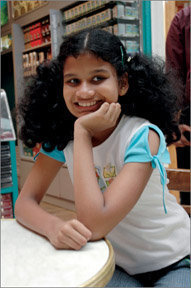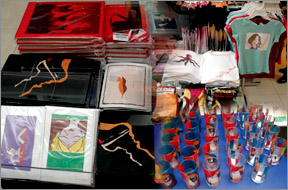Thashmi's thriving creativity
An eleven-year-old child prodigy Odel's latest
designer :
by Indeewara Thilakarathne
|

Thashmi
|
Almost every aspect of Odel, one of the highly sought-after
department stores in the island, was perfectly in order with the usual
influx of its cosmopolitan customers, scurrying from one section to
another in search of their special merchandises.
Though it was not the festive season, Odel looked almost dressed up
for a festival, perhaps, its usual festival of sales ranging from
cosmetics and expensive wrist-watches to the attractive array of Sri
Lankan made, exclusive merchandises which included t-shirts, candles of
various sizes and hues and tiny but exclusive ornamental goods with a
zeal of Asian charm.
However, an exclusive area, right in front of the cafeteria was
occupied by an array of goods bearing an extra-ordinary computer aided
designs, and drawings of imagination. The talent behind these exquisite
creations is eleven year old Thashmi, a student of the Chitra Lane
Children's Resource Centre and Odel's latest Fashion Designer.
Though Thashmi is suffering from autism, a lifelong disability which
affects communication and relationships with peers and environment, she
found an outlet of expression in computer-aided designing of artworks.
 The present collection of her works which is being displayed at Odel
till March 30 includes over 80 highly professional pieces of work on a
wide range of subjects from portraits, scenic landscapes to abstract
depiction of life, love and relationship. The present collection of her works which is being displayed at Odel
till March 30 includes over 80 highly professional pieces of work on a
wide range of subjects from portraits, scenic landscapes to abstract
depiction of life, love and relationship.
The products on display include an exclusive array of merchandise
such as t-shirts, scarves, notepads, coasters and stationery bearing
fifteen of Thashmi's highly sophisticated and exquisite pieces of art.
"I picked up her flair for computer aided artwork at the school. This
is the medium through which she expresses herself"., says the jubilant
Principal of the Chitra Lane Resource Centre, Delysia Gunadardena on the
discovery of Thashmi's talents.
To encourage her talents, Odel and Chitra Lane Children's Resource
Centre pledged to extend further support to Thashmi to enhance her
talents. The proceedings from the promotion will fund her future
education.
Through this project, Odel has not only raised public awareness on
Autism, but also provided the individuals with Autism, the best
opportunities to realize their innate potentials and to lead near normal
lives.
She showed me one design, of two dark figures and the sun and I asked
her what it was. She said it was love, says her teacher who was amazed
by Thashmi's talents.
Her talents were spotted nearly six months ago when she was
introduced to the computer at school and in her home. Like a fish taking
to water, she picked up digital drawing and techniques at an amazing
speed baffling her teachers. Thashmi's mother then turned 80 of her
designs onto a CD which was later showed to her teacher.
Thashimi would get a new computer from the proceedings of the sale
and would continue to express herself through the medium of drawing. She
is undoubtedly Odel's youngest designer and perhaps the youngest in the
world.
The Children's Resource Centre is a project of the Chitra Lane School
for the Special Child. The school was founded in 1967 and helps educate
and impart life-skills to children and young adults with special needs
to reach their potentials and to lead productive and independent lives.
About Autism
Autism is classified by the World Health Organization and American
Psychological Association as a developmental disability that results
from a disorder of the human central nervous system. It is diagnosed
using specific criteria for impairments to social interaction,
communication, interests, imagination and activities. The causes,
symptoms, etiology, treatment, and other issues are controversial.
Autism manifests itself "before the age of three years" according to
the World Health Organization's International Classification of Diseases
(ICD-10)[2] Autistic children are marked by delays in their "social
interaction, language as used in social communication, or symbolic or
imaginative play" (Diagnostic and Statistical Manual of Mental
Disorders).[3]
Autism, and the other four pervasive developmental disorders (PDD),
are all considered to be neuro-developmental disorders.
They are diagnosed on the basis of a triad, or group of three
behavioural impairments or dysfunctions: 1. impaired social interaction,
2. impaired communication and 3. restricted and repetitive interests and
activities.[4] These three basic characteristics reflect Dr. Leo
Kanner's first reports of autism emphasizing "autistic aloneness" and
"insistence on sameness."
Stacking cans (or otherwise obsessively sorting objects) at a very
young age may be an early indicator of autism. From a physiological
standpoint, autism is often less than obvious in that outward appearance
may not indicate a disorder.
Diagnosis typically comes from a complete patient history and
physical and neurological evaluation.
The incidence of diagnosed autism has increased since the 1990s. [5]
Reasons offered for this phenomenon include better diagnosis, wider
public awareness of the condition, regional variations in diagnostic
criteria, or simply an increase in the occurrence of ASD (autism
spectrum disorders).
The United States Centers for Disease Control (CDC) estimate the
prevalence of autism spectrum disorders to be about one in every 150
children.[6][7] In 2005, the National Institute of Mental Health (NIMH)
stated the "best conservative estimate" as 1 in 1000.[8].
In 2006, NIMH estimated that the incidence was 2-6 in every 1000 [9]
There are numerous theories as to the specific causes of autism, but
they are as yet unproven (see section on "Causes" below). Proposed
factors include genetic influence, anatomical variations (e.g. head
circumference), abnormal blood vessel function and oxidative stress.
Their significance as well as implications for treatment remain
speculative.
Conversely, some autistic children and adults are opposed to attempt
to cure autism. These people see autism as part of which they are,
[10][11][12] and in some cases they perceive treatments and attempts of
a cure to be unethical.
|
[email protected]
|
